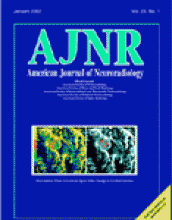We read with interest the report by Mukherji et al (1) concerning the use of thallium-201 single-photon emission CT to detect primary squamous cell carcinoma of the head and neck. The authors clearly show that high accuracy is obtained for thallium-201 single-photon emission CT in the differential diagnosis of recurrent tumor versus treatment effect in this tumor group, surpassing the reliability of CT in detecting this problem. We bring to the attention of your readers our work (2), which suggests another potentially important area of diagnostic benefit from thallium-201, specifically the ability to obtain prognostic information concerning the expected biological aggressivity of a childhood brain tumor. Abnormal thallium-201 uptake in this population appeared to denote a subgroup of lesions with distinctly greater mortality and morbidity. Thallium-201-avid lesions showed a 50% shorter period of recurrence-free survival from the time of diagnosis (P < .01). These findings exceeded the specificity of correlated structural imaging, mainly MR imaging. It would be of interest to know whether Dr. Mukherji and colleagues found any similar trends with respect to the different groups of cancer of the head and neck.
Both the University of North Carolina and our study thus suggest that the widely available and relatively inexpensive agent, thallium-201, provides important functional information regarding the biological behavior of brain tumors, which cannot generally be gleaned from the structural imaging findings alone. If confirmed in further clinical experience, this information has great potential benefit and may influence patient counseling regarding long-term outcome and be useful in the selection of the best treatment protocols.
References
Reply
We thank Drs. O’Tuama and Poussaint for their interest in our work (1). Our study group consisted of patients with recurrent tumors and not primary neoplasms. Thus, we did not have the ability to investigate the prognostic capability of thallium-201 before treatment. It would have been difficult to draw any such conclusions from our patient population, because we evaluated previously treated patients for recurrent disease and the effect of thallium uptake after various forms of treatment had not been sufficiently investigated.
Drs. O’Tuama and Poussaint raise a potentially important use of thallium with respect to predicting treatment response and potentially stratifying treatment regimens on the basis of objective quantitative criteria. I would call their attention to the work of Nagamachi et al (2, 3). This group performed a semiquantitative measurement of thallium-201 to predict the response of squamous cell carcinoma of the head and neck to radiation therapy. The measurements consisted of a thallium-201 retention index; the details of this technique are described in their articles. Nagamachi et al (3) found that the pretreatment retention index was predictive of response to radiation therapy. A high retention index was predictive of ≥50% reduction in size of the primary site (complete or partial response), whereas a low retention index was predictive of <50% response (3). We have recently evaluated the ability of combined pre- and post-thallium-201 to predict response in squamous cell carcinoma of the head and neck treated with nonsurgical organ preservation therapy (4). Our preliminary results showed that persistence of activity in the primary site at 6 weeks after completion of therapy was indicative of persistent tumor, whereas loss of uptake was indicative of local control (4). We did not, however, quantify the pretreatment thallium uptake of the tumors in this report (4). This is something we can certainly consider investigating in future studies to shed more light on the insightful inquiry presented by Drs. O’Tuama and Poussaint.
- American Society of Neuroradiology












